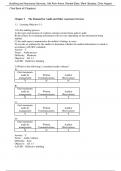Exam (elaborations)
Auditing and Assurance Services, 18e Alvin Arens, Randal Elder, Mark Beasley, Chris Hogan (Test Bank)
Module
Auditing and Assurance Services, 18e Alvin Arens,
Institution
Auditing And Assurance Services, 18e Alvin Arens,
Auditing and Assurance Services, 18e Alvin Arens, Randal Elder, Mark Beasley, Chris Hogan (Test Bank)
Auditing and Assurance Services, 18e Alvin Arens, Randal Elder, Mark Beasley, Chris Hogan (Test Bank)
[Show more]
Preview 4 out of 1071 pages
Uploaded on
May 9, 2023
Number of pages
1071
Written in
2022/2023
Type
Exam (elaborations)
Contains
Questions & answers
Institution
Auditing and Assurance Services, 18e Alvin Arens,
Module
Auditing and Assurance Services, 18e Alvin Arens,
By: egonzperez • 9 months ago
£23.96
Also available in package deal from £34.53
100% satisfaction guarantee
Immediately available after payment
Both online and in PDF
No strings attached
Also available in package deal (1)
Auditing and Assurance Services, 18e Alvin Arens, Randal Elder, Mark Beasley, Chris Hogan (Solution Manual with Test Bank Latest Edition 2023-24, Grade A , 100% Verified)
1. Exam (elaborations) - Auditing and assurance services, 18e alvin arens, randal elder, mark beasley, chris ...
2. Exam (elaborations) - Auditing and assurance services 18th edition by alvin arens, randal elder, mark beas...
Show more
1 Copyright © 2023 Pearson Education, Inc. Chapter 1 The Demand for Audit and Other Assurance Services 1.1 Learning Objective 1 -1 1) In the auditing process, A) the types and amounts of evidence remain constant from audit to audit. B) the criteria for evaluating information will not vary depending on the information being audited. C) the audit report communicates the auditor's findings to users. D) records are gathered by the auditor to determine whether the audited informatio n is stated in accordance with SEC standards. Answer: C Terms: Audit process Difficulty: Moderate Objective: LO 1-1 AACSB: Reflective thinking 2) Which of the following is considered audit evidence? A) Oral statements made by management Written Communications Auditor Observations Y N N B) Oral statements made by management Written Communications Auditor Observations N Y Y C) Oral statements made by management Written Communications Auditor Observations Y Y Y D) Oral statements made by management Written Communications Auditor Observations N N Y Answer: C Terms: Audit evidence Difficulty: Easy Objective: LO 1-1 AACSB: Reflective thinking (Auditing and Assurance Services, 18e Alvin Arens, Randal Elder, Mark Beasley, Chris Hogan)




